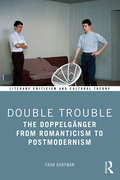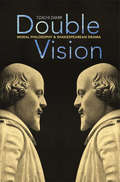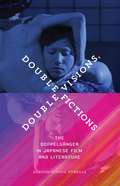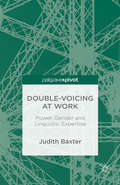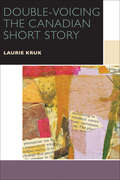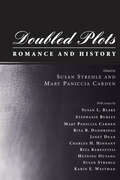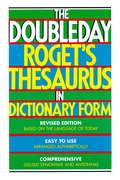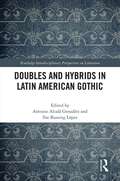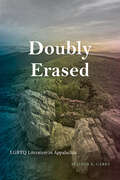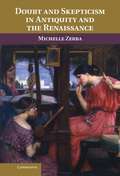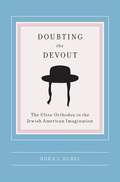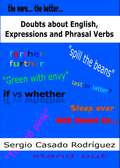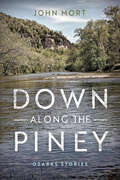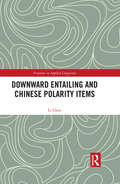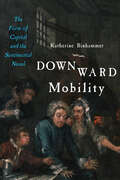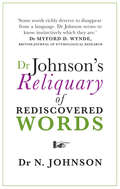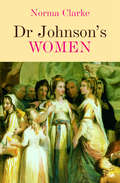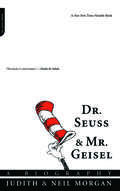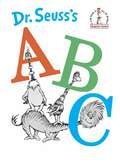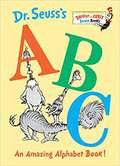- Table View
- List View
Double Trouble: The Doppelgänger from Romanticism to Postmodernism (Literary Criticism and Cultural Theory)
by Eran DorfmanThe double, doppelgänger, is mostly understood as a peculiar figure that emerged in nineteenth-century Romantic and gothic literature. Far from being a merely esoteric entity, however, this book argues that the double, although it mostly goes unnoticed, is a widespread phenomenon that has significant influence on our lives. It is an inherent key element of human subjectivity whose functions, forms, and effects have not yet gained the serious consideration they merit. Drawing on literature, philosophy, and psychoanalysis, and combining a personal story with theoretical interventions, Double Trouble develops a novel understanding of the double and human subjectivity in the last two centuries. It begins with the singular and narcissistic double of Romanticism and gradually moves to the multiple doubles implicated by Postmodernism. The double is what defies unicity and opens up the subject to multiplicity. Consequently, it gradually emerges as a bridge between the I and the Other, identity and difference, philosophy and literature, theory and praxis.
Double Vision: Moral Philosophy and Shakespearean Drama
by Tzachi ZamirHamlet tells Horatio that there are more things in heaven and earth than are dreamt of in his philosophy. In Double Vision, philosopher and literary critic Tzachi Zamir argues that there are more things in Hamlet than are dreamt of--or at least conceded--by most philosophers. Making an original and persuasive case for the philosophical value of literature, Zamir suggests that certain important philosophical insights can be gained only through literature. But such insights cannot be reached if literature is deployed merely as an aesthetic sugaring of a conceptual pill. Philosophical knowledge is not opposed to, but is consonant with, the literariness of literature. By focusing on the experience of reading literature as literature and not philosophy, Zamir sets a theoretical framework for a philosophically oriented literary criticism that will appeal both to philosophers and literary critics. Double Vision is concerned with the philosophical understanding induced by the aesthetic experience of literature. Literary works can function as credible philosophical arguments--not ones in which claims are conclusively demonstrated, but in which claims are made plausible. Such claims, Zamir argues, are embedded within an experiential structure that is itself a crucial dimension of knowing. Developing an account of literature's relation to knowledge, morality, and rhetoric, and advancing philosophical-literary readings of Richard III, Macbeth, Romeo and Juliet, Othello, Antony and Cleopatra, Hamlet, and King Lear, Zamir shows how his approach can open up familiar texts in surprising and rewarding ways.
Double Visions, Double Fictions: The Doppelgänger in Japanese Film and Literature
by Baryon Tensor PosadasA fresh take on the dopplegänger and its place in Japanese film and literature—past and present Since its earliest known use in German Romanticism in the late 1700s, the word Dopplegänger (double-walker) can be found throughout a vast array of literature, culture, and media. This motif of doubling can also be seen traversing historical and cultural boundaries. Double Visions, Double Fictions analyzes the myriad manifestations of the dopplegänger in Japanese literary and cinematic texts at two historical junctures: the interwar period of the 1920s and 1930s and the present day.According to author Baryon Tensor Posadas, the doppelgänger marks the intersection of the historical impact of psychoanalytic theory, the genre of detective fiction in Japan, early Japanese cinema, and the cultural production of Japanese colonialism. He examines the doppelgänger’s appearance in the works of Edogawa Rampo, Tanizaki Jun’ichiro, and Akutagawa Ryunosuke, as well as the films of Tsukamoto Shin’ya and Kurosawa Kiyoshi, not only as a recurrent motif but also as a critical practice of concepts. Following these explorations, Posadas asks: What were the social, political, and material conditions that mobilized the desire for the dopplegänger? And how does the dopplegänger capture social transformations taking place at these historical moments?Double Visions, Double Fictions ultimately reveals how the dopplegänger motif provides a fascinating new backdrop for understanding the enmeshment of past and present.
Double-voicing at Work: Power, Gender and Linguistic Expertise
by Judith BaxterThis book reveals how 'double-voicing' is an inherent and routine part of spoken interactions within institutional contexts. Baxter's research shows that women use double-voicing more than men as a means of gaining acceptance and approval in the workplace. Double-voicing thus involves an interplay between power, gender and linguistic expertise.
Double-Voicing the Canadian Short Story (Canadian Literature Collection)
by Laurie KrukDouble-Voicing the Canadian Short Story is the first comparative study of eight internationally and nationally acclaimed writers of short fiction: Sandra Birdsell, Timothy Findley, Jack Hodgins, Thomas King, Alistair MacLeod, Olive Senior, Carol Shields and Guy Vanderhaeghe. With the 2013 Nobel Prize for Literature going to Alice Munro, the “master of the contemporary short story,” this art form is receiving the recognition that has been its due and—as this book demonstrates—Canadian writers have long excelled in it. From theme to choice of narrative perspective, from emphasis on irony, satire and parody to uncovering the multiple layers that make up contemporary Canadian English, the short story provides a powerful vehicle for a distinctively Canadian “double-voicing”. The stories discussed here are compelling reflections on our most intimate roles and relationships and Kruk offers a thoughtful juxtaposition of themes of gender, mothers and sons, family storytelling, otherness in Canada and the politics of identity to name but a few. As a multi-author study, Double-Voicing the Canadian Short Story is broad in scope and its readings are valuable to Canadian literature as a whole, making the book of interest to students of Canadian literature or the short story, and to readers of both.
Doubled Plots: Romance and History
by Susan Strehle Mary Paniccia CardenIn art, myth, and popular culture, romance is connected with the realm of emotions, private thought, and sentimentality. History, its counterpart, is the seemingly objective compendium of public fact. In theory, the two genres are diametrically opposed, offering widely divergent views of human experience.In this collection of essays, however, the writers challenge these basic assumptions and consider the two as parallel and as reflections of each other. Looking closely at specific narratives, they argue that romance and history share expectations and purposes and create the metaphors that can either hold cultures and institutions together or drive them apart. The writers explore the internal contradictions of both genres, as seen in works in which the elements of both romance and history are present. The theme that flows throughout this collection is that romance literature and art frequently engage with or comment on actual historical events or histories.Included among the contributions are discussions of romance and race in James Fenimore Cooper's The Last of the Mohicans, the Rudolph Valentino film classic The Sheik, the series of English “Regency Romance” novels, the constructs of love and history in two of Alice McDermott's novels, and a feminist reading of African American women's historical romances.Moreover, the essays approach romance and history from a variety of critical and political perspectives and examine a wide selection of romances from the 1800s to contemporary times. They look at bestsellers and literary classics, at texts by and for white audiences, and at works created by writers on the margins of Western culture.The anthology is a radical approach to romance, a genre often dismissed as diversionary and reactionary. It explores how well this genre serves for critical examinations of history.
The Doubleday Roget's Thesaurus in Dictionary Form
by Sidney I. Landau Ronald J. BogusA reference book that belongs on every desk--one of the handiest, best-organized, and most reliable thesauruses available, newly updated to reflect the American language of today.
Doubles and Hybrids in Latin American Gothic (Routledge Interdisciplinary Perspectives on Literature)
by Antonio Alcalá González Ilse Bussing LópezDoubles and Hybrids in Latin American Gothic focuses on a recurrent motif that is fundamental in the Gothic—the double. This volume explores how this ancient notion acquires tremendous force in a region, Latin America, which is itself defined by duplicity (indigenous/European, autochthonous religions/Catholic). Despite this duplicity and at the same time because of it, this region has also generated "mestizaje," or forms resulting from racial mixing and hybridity. This collection, then, aims to contribute to the current discussion about the Gothic in Latin America by examining the doubles and hybrid forms that result from the violent yet culturally fertile process of colonization that took place in the area.
Doubling and Incest / Repetition and Revenge: A Speculative Reading of Faulkner
by John IrwinThis expanded edition makes available once again John Irwin's masterful exposition on the unconscious desire and doubling that inform the novels.
Doubly Erased: LGBTQ Literature in Appalachia (SUNY series in Queer Politics and Cultures)
by Allison E. CareyThe first book of its kind, Doubly Erased is a comprehensive study of the rich tradition of LGBTQ themes and characters in Appalachian novels, memoirs, poetry, drama, and film. Appalachia has long been seen as homogenous and tradition-bound. Allison E. Carey helps to remedy this misunderstanding, arguing that it has led to LGBTQ Appalachian authors being doubly erased—routinely overlooked both within United States literature because they are Appalachian and within the Appalachian literary tradition because they are queer. In exploring motifs of visibility, silence, storytelling, home, food, and more, Carey brings the full significance and range of LGBTQ Appalachian literature into relief. Dorothy Allison's Bastard Out of Carolina and Alison Bechdel's Fun Home are considered alongside works by Maggie Anderson, doris davenport, Jeff Mann, Lisa Alther, Julia Watts, Fenton Johnson, and Silas House, as well as filmmaker Beth Stephens. While primarily focused on 1976 to 2020, Doubly Erased also looks back to the region's literary "elders," thoughtfully mapping the place of sexuality in the lives and works of George Scarbrough, Byron Herbert Reece, and James Still.
Doubt and Skepticism in Antiquity and the Renaissance
by Michelle ZerbaThis book is an interdisciplinary study of the forms and uses of doubt in works by Homer, Sophocles, Aristophanes, Cicero, Machiavelli, Shakespeare, and Montaigne. Based on close analysis of literary and philosophical texts by these important authors, Michelle Zerba argues that doubt is a defining experience in antiquity and the Renaissance, one that constantly challenges the limits of thought and representation. The wide-ranging discussion considers issues that run the gamut from tragic loss to comic bombast, from psychological collapse to skeptical dexterity, and from solitary reflection to political improvisation in civic contexts and puts Greek and Roman treatments of doubt into dialogue not only with sixteenth-century texts, but with contemporary works as well. Using the past to engage questions of vital concern to our time, Zerba demonstrates that although doubt sometimes has destructive consequences, it can also be conducive to tolerance, discovery, and conversation across sociopolitical boundaries.
Doubting the Devout: The Ultra-Orthodox in the Jewish American Imagination (Religion and American Culture)
by Nora L RubelBefore 1985, depictions of ultra-Orthodox Jews in popular American culture were rare, and if they did appear, in films such as Fiddler on the Roof or within the novels of Chaim Potok, they evoked a nostalgic vision of Old World tradition. Yet the ordination of women into positions of religious leadership and other controversial issues have sparked an increasingly visible and voluble culture war between America's ultra-Orthodox and non-Orthodox Jews, one that has found a particularly creative voice in literature, media, and film.Unpacking the work of Allegra Goodman, Tova Mirvis, Pearl Abraham, Erich Segal, Anne Roiphe, and others, as well as television shows and films such as A Price Above Rubies, Nora L. Rubel investigates the choices non-haredi Jews have made as they represent the character and characters of ultra-Orthodox Jews. In these artistic and aesthetic acts, Rubel recasts the war over gender and family and the anxieties over acculturation, Americanization, and continuity. More than just a study of Jewishness and Jewish self-consciousness, Doubting the Devout will speak to any reader who has struggled to balance religion, family, and culture.
Doubting the Devout: The Ultra-Orthodox in the Jewish American Imagination
by Nora L. RubelBefore 1985, depictions of ultra-Orthodox Jews in popular American culture were rare, and if they did appear, in films such as Fiddler on the Roof or within the novels of Chaim Potok, they evoked a nostalgic vision of Old World tradition. Yet the ordination of women into positions of religious leadership and other controversial issues have sparked an increasingly visible and voluble culture war between America's ultra-Orthodox and non-Orthodox Jews, one that has found a particularly creative voice in literature, media, and film. Unpacking the work of Allegra Goodman, Tova Mirvis, Pearl Abraham, Erich Segal, Anne Roiphe, and others, as well as television shows and films such as A Price Above Rubies, Nora L. Rubel investigates the choices non-haredi Jews have made as they represent the character and characters of ultra-Orthodox Jews. In these artistic and aesthetic acts, Rubel recasts the war over gender and family and the anxieties over acculturation, Americanization, and continuity. More than just a study of Jewishness and Jewish self-consciousness, Doubting the Devout will speak to any reader who has struggled to balance religion, family, and culture.
Doubts about English, Expressions and Phrasal Verbs
by Sergio Casado RodríguezIntroduction I like quick and simple explanations as you will appreciate. Especially when it comes to grammatical issues, in spite of the fact that there may be cases when one has to extend things a little further. I believe that things are learned little by little, and in studying foreign languages it is better to learn a more reduced usage of concepts and then widen it with the passing of time. I was always against having to study a mountain of rules from start to finish, then when the time comes to use them the rules are not going to be useful to me because I don't have a good command of the language. In the first part of the book I have compiled 29 doubts that my students frequently bring up to me, or that I have had myself. The 29 are going to be of great help because they come up frequently when it comes time to use them in conversation as well as when it is time to take an exam. Regarding the number of English expressions that I have chosen, I have noted a number of them that I feel are adequate, without being excessive or lacking. It is common to see the success of those posts or videos that have 400 phrasal verbs, but let's be honest. Not only will it be that no one is going to memorize those phrasal verbs, but there will be few people that will get to read them all.
Down Along the Piney: Ozarks Stories (Richard Sullivan Prize In Short Fiction Ser.)
by John MortDown Along the Piney is John Mort’s fourth short-story collection and winner of the Richard Sullivan Prize in Short Fiction. With settings in Florida, California, Mexico, Chicago, the Texas Panhandle, and, of course, the Ozarks themselves, these thirteen stories portray the unsung, amusing, brutal, forever hopeful lives of ordinary people. Mort chronicles the struggles of "flyover" people who live not just in the Midwest, but anywhere you can find a farm, small town, or river winding through forested hills. Mort, whose earlier stories have appeared in the New Yorker, GQ, and The Chicago Tribune, is the author of the award-winning Vietnam War novel Soldier in Paradise, as well as Goat Boy of the Ozarks and The Illegal. These ironic, unflaggingly honest stories will remind the reader of Jim Harrison, Sherwood Anderson, and Shirley Jackson.
Down in My Heart, Second Edition
by William Stafford(From the back cover) "Down in My Heart has an autobiographical dimension, a shy but brave sense of quest, of inner evolution, of maturation and growth from eager idealism at the beginning to ironic wariness verging on disillusionment at the close, that was so telling a measure for all of us who shared the CO experience. But. Stafford registers a feeling of absolute integrity within a situation of social alienation that is extraordinary, the more so because it is unconscious, emerging as the subsumed virtue of the work. In the quiet immediacy of his prose the future poet is alive and breathing. All in all, a perceptive glimpse into a most painful interval of our national life." --William Everson From 1940 to 1944, William Stafford was interned in the camps for conscientious objectors in the United States. As a pacifist, he worked for the Civilian Public Service on forest and soil conservation projects in Arkansas, California, and Illinois. As a writer, he recorded the life he found there; the fellowship within the camps and the antagonism outside them. Down in My Heart is an account of the relationships among the people in the camps, their day-to-day activities: fighting forest fires, building roads, terracing eroded lands, and their earnest pursuit of a social morality rooted in religious and secular pacifist ideals. Since then, William Stafford has published several collections of poetry, and he has published his views on the writer's vocation. He has been the Poetry Consultant for the Library of Congress, and received the highest praise as a poet and an educator. His awards include the National Book Award, the Shelley Memorial Award, and the American Academy and Institute of Arts and Letters Award in Literature.
Down on the Ranch
by Ellen Leigh Aleksey IvanovThe fun and excitement of English and Language Arts learning continues in Grade 2 of Reading Street. This comprehensive and dynamic curriculum for homeschooling is geared toward young children who have some foundational English and Language Arts knowledge and are ready to strengthen their skills. Comprised of engaging activities, challenging content and weekly quizzes, Reading Street: Grade 2 is the next step in your child's path toward becoming a lifelong learner and reader. As with all Reading Street products, the Grade 2 system is formatted to help students meet certain age-appropriate goals. After completing this English and Language Arts homeschool program, your child should be able to: Read and comprehend two-syllable words. Identify common prefixes (such as pre-, un-, or re-) and suffixes (such as -able, -ad and -er). Correct mistakes made when reading out loud. Read books with two or more chapters. Understand the structure of stores (i. e. beginning, middle and end). Start selecting reading materials based on his/her own interests. Identify the "who," "what," "when," "where," "why" and "how" of the text. While the goals of second Grade English and Language Arts are numerous, Reading Street will help you craft engrossing lessons. Your child will garner important English and Language Arts skills while completing a workbook, reading stories and poems, and taking assessments. Planning these lessons will be easier than ever, as all Reading Street systems are broken down into weekly Big Ideas. All the work your child does on a given week is formulated around that single concept for an organized and challenging curriculum. With six easy-to-follow units, Reading Street: Grade 2 is the perfect tool for homeschooling parents. Your child will enjoy the reading selections and activities, and you'll love to see your student growing into a knowledgeable individual. We're confident that this product is the right one for you. For more information on the specific materials found in Grade 2 of Reading Street, check out the Features and Benefits page.
Downward Entailing and Chinese Polarity Items (Frontiers in Applied Linguistics)
by Li ChenPolarity phenomena are pervasively observed in natural languages. Previous studies on Chinese polarity items are mainly in line with the non-veridicality approach. This book, however, employs the downward-entailing hypothesis as its analytical foundation, and argues that downward entailment is the only licensor for different kinds of Chinese polarity items, and non-veridicality is neither a necessary nor sufficient condition and thus offers inferior explanatory power compared with the former. To begin with, it lays the groundwork for this research by presenting a brief introduction to polarity phenomena and reviewing the existing relevant theories. Then it addresses the status of the commonly used element dou in Chinese. Specifically, it applies the tripartite structural frame to the studies of dou, and examines the role of dou in licensing the polarity items. Moreover, it investigates the properties and behavior of dou with respect to modality. Based on the analysis above, it observes that non-interrogative wh-indeterminates in Chinese can be licensed in the restriction domain of a necessity operator. Also, the non-uniformity of three Chinese polarity items, i.e., shenme, na-CL, and renhe, is scrutinized within the downward-entailing framework. This book will appeal to scholars, teachers and students in the field of linguistics, especially in the areas of formal semantics and generative grammar. Researchers and engineers in cloud computing and big data who are seeking help from linguistic contributions to meaning and logic will also benefit from it.
Downward Mobility: The Form of Capital and the Sentimental Novel
by Katherine BinhammerHow do the stories we tell about money shape our economies?Beginning in the late eighteenth century, as constant growth became the economic norm throughout Europe, fictional stories involving money were overwhelmingly about loss. Novel after novel tells the tale of bankruptcy and financial failure, of people losing everything and ending up in debtor's prison, of inheritances lost and daughters left orphaned and poor. In Downward Mobility, Katherine Binhammer argues that these stories of ruin are not simple tales about the losers of capitalism but narratives that help manage speculation of capital's inevitable collapse.Bringing together contemporary critical finance studies with eighteenth-century literary history, Binhammer demonstrates the centrality of the myth of downward mobility to the cultural history of capitalism—and to the emergence of the novel in Britain. Deftly weaving economic history and formal analysis, Binhammer reveals how capitalism requires the novel's complex techniques to render infinite economic growth imaginable. She also explains why the novel's signature formal developments owe their narrative dynamics to the contradictions within capital's form. Combining new archival research on the history of debt with original readings of sentimental novels, including Frances Burney's Cecilia and Camilla, Sarah Fielding's David Simple, and Oliver Goldsmith's The Vicar of Wakefield, Downward Mobility registers the value of literary narrative in interpreting the complex sequences behind financial capitalism, especially the belief in infinite growth that has led to current environmental crises. An audacious epilogue arms humanists with the argument that, in order to save the planet from unsustainable growth, we need to read more novels.
Dr. Johnson and Mr. Savage
by Richard Holmes"Dr. Johnson & Mr. Savage" recounts a story of a mysterious eighteenth-century friendship between Richard Savage -- poet, playwright, and convicted murderer -- and the young Samuel Johnson, an unknown provincial schoolmaster just arrived in London to seek his literary fortune. Holmes shows how the bond between Savage and Johnson revolutionized the art of biography.
Dr Johnson's Reliquary of Rediscovered Words
by Dr Neil JohnsonIn these pages you will discover words you never knew existed, and rediscover many that you had forgotten or had given up all hope of ever seeing again.If the amoindering of our language by fifish chuffs leads you to fleer and the infandous overslipping of orthoepy makes you feel wamble, this is most certainly the book for you.Prepare to fike, gane and gaure as Dr Johnson certiorates, carrying carotic catachresis to new heights, and providing all lovers of leguleian lexicographical detail with a rich feast of mullock, cultch and peltry.
Dr Johnson's Women
by Norma ClarkeDr Johnson's friendships with the leading women writers of the day was an important feature of his life and theirs. He was willing to treat women as intellectual equals and to promote their careers: something ignored by his main biographer, James Boswell. Dr Johnson's Women investigates the lives and writings of six leading female authors Johnson knew well: Elizabeth Carter, Charlotte Lennox, Elizabeth Montagu, Hester Thrale, Hannah More and Fanny Burney. It explores their relationships with Johnson, with each other and with the world of letters. It shows what it was like to be a woman writer in the 'Age of Johnson'. It is often assumed that women writers in the eighteenth century suffered the same restrictions and obstacles that confronted their Victorian successors. Norma Clarke shows that this was by no means the case. Highlighting the opportunities available to women of talent in the eighteenth century, Dr Johnson's Women makes clear just how impressive and varied their achievements were.
Dr. Seuss & Mr. Geisel: A Biography
by Judith Morgan Neil MorganHorton, Thidwick, Yertle, the Lorax, the Grinch, Sneetches, and the Cat in the Hat are just a handful of the bizarre and beloved characters Theodor S. Geisel (1904#150;1991), alias Dr. Seuss, created in his forty-seven children's books, from 1937's And to Think That I Saw It on Mulberry Street to 1990's Oh, the Places You'll Go! During his lifetime Dr. Seuss was honored with numerous degrees, three Academy Awards, and a Pulitzer, but the man himself remained a reclusive enigma. In this first and only biography of the good doctor, the authors, his close friends for almost thirty years, have drawn on their firsthand insights as well as his voluminous papers; the result is an illuminating, intimate portrait of a dreamer who saw the world "through the wrong end of a telescope," and invited us to enjoy the view.
Dr. Seuss's ABC (Beginner Books(R))
by Dr. SeussArguably the most entertaining alphabet book ever written, this classic Beginner Book by Dr. Seuss is perfect for children learning their ABCs. Featuring a fantastic cast of zany characters—from Aunt Annie&’s alligator to the Zizzer-Zazzer-Zuzz, with a lazy lion licking a lollipop and an ostrich oiling an orange owl—Dr. Seuss&’s ABC is a must-have for every young child&’s library. Originally created by Dr. Seuss, Beginner Books encourage children to read all by themselves, with simple words and illustrations that give clues to their meaning.
